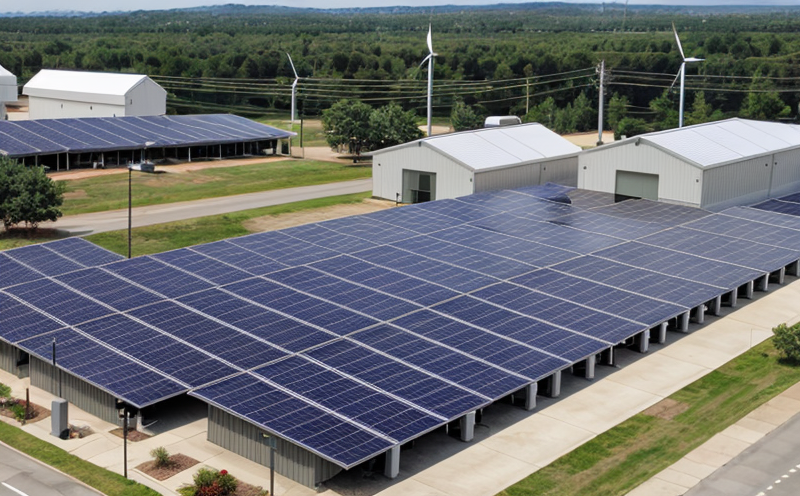IEC 60068 Environmental Stress Testing for Distributed Systems
The International Electrotechnical Commission (IEC) Standard IEC 60068 is a widely recognized set of specifications that define the methods and parameters for environmental stress testing. For distributed energy systems, this standard plays a crucial role in ensuring that these complex systems can withstand various environmental stresses, from high temperatures to humidity variations, thus enhancing their reliability and durability.
Environmental stress tests are essential for distributed energy systems because they simulate real-world conditions under which the system will operate. This testing helps manufacturers identify potential weaknesses and improve product design before deployment. For instance, a microgrid designed for operation in tropical climates must be tested to ensure it can withstand high humidity levels without performance degradation.
Testing according to IEC 60068 involves subjecting specimens to various environmental conditions such as temperature cycling (from -40°C up to 150°C), humidity, and pressure changes. The aim is to evaluate how well the distributed system can handle these stresses without failure. This process ensures that the microgrid or other energy systems will function reliably in harsh environments.
The testing protocol must also account for the unique characteristics of distributed systems, such as their modular nature and diverse components. Each component within a microgrid—be it inverters, batteries, or sensors—must be tested individually to ensure they can operate cohesively under environmental stresses. This holistic approach guarantees that the entire system functions optimally in its intended environment.
The results of these tests are critical for compliance with international standards and regulations, which vary by region but often align closely with IEC guidelines. By adhering to these testing procedures, manufacturers can ensure their products meet global market demands and are well-prepared for deployment in diverse geographic locations.
- High temperature testing up to 150°C
- Low temperature cycling down to -40°C
- Humidity cycling between 20% RH and 98% RH
- Pressure changes from standard atmosphere to 300 kPa
- Shock testing for vibration resistance
These tests are not just about compliance; they represent a commitment to quality and reliability. By conducting rigorous environmental stress tests, manufacturers can build trust with clients and regulatory bodies alike. This approach ensures that the distributed energy systems are robust enough to operate efficiently in various climatic conditions, thereby enhancing overall system performance and longevity.
In conclusion, IEC 60068 testing is an integral part of ensuring the reliability and durability of distributed energy systems like microgrids. By subjecting these systems to a range of environmental stresses, manufacturers can identify potential issues early in the development process, leading to improved product quality and enhanced customer satisfaction.
Why It Matters
The significance of IEC 60068 testing for distributed energy systems cannot be overstated. These tests are vital for several reasons:
- Enhanced Reliability: By simulating real-world conditions, these tests help manufacturers identify and rectify potential issues before the product reaches the market.
- Regulatory Compliance: Adhering to international standards ensures that distributed energy systems meet global regulatory requirements, facilitating smoother market entry and broader acceptance in diverse regions.
- Customer Trust: Demonstrating a commitment to high-quality testing builds trust with customers and stakeholders. This trust is essential for long-term business relationships and customer satisfaction.
- Economic Benefits: Early detection of issues through rigorous testing can prevent costly rework or product failures, leading to substantial savings in the long run.
In an increasingly interconnected world, where energy systems must operate reliably across diverse geographic locations, IEC 60068 testing is not just a technical requirement but also a strategic investment. It ensures that distributed energy systems are not only robust but also sustainable and efficient in their operations.
Industry Applications
The application of IEC 60068 environmental stress testing extends across multiple sectors, including renewable energy, infrastructure development, and urban planning. These tests are particularly crucial for distributed energy systems such as microgrids, which play a vital role in enhancing grid resilience and sustainability.
Microgrids are self-sustaining power networks that can operate independently or in parallel with the main grid. Testing these systems according to IEC 60068 ensures they can handle extreme weather conditions, such as hurricanes or heatwaves, which can disrupt traditional grid operations. This resilience is especially important for critical infrastructure like hospitals and data centers.
In addition to microgrids, other distributed energy systems that benefit from this testing include:
- Solar power plants
- Battery storage systems
- Wind farms integrated with local grids
- Smart grid components
The reliability of these systems in harsh environments can significantly enhance their economic and environmental benefits. For instance, a solar farm operating in a desert environment must be tested to ensure it can withstand high temperatures and dust accumulation without performance degradation.
Moreover, the testing process also extends to the integration of renewable energy sources into existing grid infrastructure. By ensuring that these components are robust enough to handle various environmental stresses, IEC 60068 testing supports a more sustainable and resilient power supply system.
International Acceptance and Recognition
IEC 60068 is widely recognized and accepted across the globe for its rigorous approach to environmental stress testing. Its acceptance in various countries underscores its importance in ensuring product reliability and compliance with international standards.
- Australia: The Australian Standards Association (AS) aligns many of its specifications with IEC 60068, emphasizing the standard's global relevance.
- European Union: EU directives often reference IEC guidelines to ensure consistent quality across member states.
- United States: While not all U.S. regulations directly cite IEC standards, many industry practices and voluntary certifications do adhere to these testing protocols.
The widespread acceptance of IEC 60068 is a testament to its effectiveness in promoting uniform quality across diverse markets. This recognition ensures that products tested according to this standard are consistently reliable regardless of their intended market or deployment location.
By adhering to these testing protocols, manufacturers can ensure that their distributed energy systems meet the stringent requirements set by international standards. This adherence not only facilitates easier compliance with local regulations but also enhances product reputation and market competitiveness.





